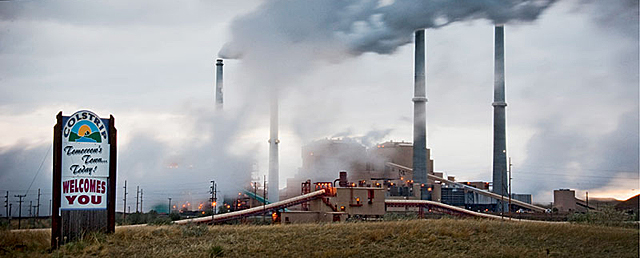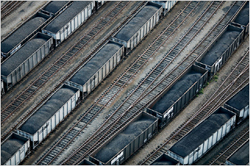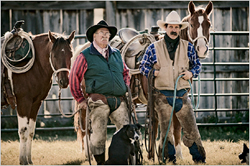sierraclub.org - sierra magazine - march/april 2010 - high plains poison


High Plains Poison
Montanans fear coal's residues more than its role in disrupting Earth's climate
By Rick Bass

I begin my journey into Montana's coal hell at the Little Bighorn Battlefield. I'm on my way to eastern Montana's enormous coal-fired power plant at Colstrip, the second largest west of the Mississippi. Colstrip is in the forgotten country east of Billings, down near the Wyoming and South Dakota borders. A lot of coal is under that part of Montana—100 to 200 years' worth of the fossil-fuel gravy train, some say, there for the digging. Most of it is shipped off to power plants in the upper Midwest, but one boxcar-full is burned every five minutes at Colstrip.
It's September, dusk. It seems to me that these rolling umber hills are pleasing to the very musculature of our bodies—that we were made, in the long ago, to walk such hills, to take pleasure in the sight, texture, and sound of the sweeping grasses. Horses stand in fields, their manes and tails blowing like the grass itself. Black Angus graze the hillsides. The clouds beyond are the same shape as the hills.

Left: Just west of Colstrip is the Little Bighorn Battlefield, the legacy of 19th-century mining wars. Right: Colstrip's toxic coal ash ponds are rated among the most hazardous in the nation.
In eastern Montana, however, the gentle overburden of life—prairie grass, horses, cattle—rests thinly over Paleozoic swamps. For tens of millions of years, vegetation fed by the photosynthetic clamor of the young earth thrived and grew, absorbing huge amounts of carbon dioxide in the process. Then rotting, death piled on death, the swamps sank lower and lower, compressing in a lightless, airless crypt. Their remains are stacked in brittle strata, sometimes only 40 or 50 feet down. Now the energy of that prehistoric sunlight, and its entombed carbon, is being released to the sun again.
Not so deep are the remains of men. At the Little Bighorn, the National Park Service, in conjunction with the Cheyenne and Crow Nations, has done an impressive job of interpreting that long-ago battle. Austere white-marble headstones have been placed on the hill where bones were found—clusters indicating concerted stands, scattered memorials commemorating more isolated struggles. The clash between cultures may have been inevitable, but it was brought to a head by mining. Only a few years after a treaty had granted the Black Hills to the tribes in perpetuity, they swarmed with white miners. In 1874, the Park Service reports, the United States "sent a geological team, under Custer, to examine the minerals in the area. Gold was among the minerals found, and not Caesar himself could have stopped the barbarian hordes of miners flowing into the reservation."
 The Colstrip power plant burns a boxcar-full of coal every five minutes around the clock.
The Colstrip power plant burns a boxcar-full of coal every five minutes around the clock.
I head for Colstrip through blue dusk and then into the night. Every now and again I descend a rolling hill into a velvet basin of pines and grass, where in the distance the lone light of a ranch burns. More often there is only darkness.
Inside the town limits, it feels strangely like Houston, humid and deeply sulfurous. (The smell of money, as people say.) The humidity is from all the water—pumped from under the desert or piped from distant shallow rivers—that is used to cool the plant, which looks like a set from a Batman movie, black as obsidian, laced with rows of lights, a blinding necklace of impure power.
Colstrip sits at the northern edge of the Powder River Basin, a huge area that stretches down through lower Montana and eastern Wyoming and that has become our latest national sacrifice zone. The area supplies one-third of the nation's coal—more than any other part of the country. The coal here is low-grade, providing only two-thirds as much energy per pound as Appalachian fuel.
It's also full of contaminants—its high sodium content, for instance, builds up a thick slag on the interior of the Colstrip boilers that is sometimes removed by dynamite—but it is very low in sulfur dioxide. It took the Clean Air Act's requirement that coal plants scrub sulfur dioxide from their emissions to make Powder River coal commercially viable; with less SO2 to scrub away, Montana and Wyoming's coal became competitive with Appalachia's.
Coal battlefields lie all over the eastern half of Montana, a state of Russian proportions with a single area code and a single congressional district. There's long-wall mining deep below the surface at Roundup, a proposed strip mine at Miles City, a proposed coal train that would cut through the Tongue River Valley, and coal-bed methane despoliation down at Decker. Here in Montana the Wild West lives on as a coal-suck free-for-all.
The reason it's so cheap for coal producers and power companies to mine and burn coal, and to dispose of its waste, is that they don't have to pay the full costs; you do. And the closer you live to Colstrip, the more you pay. Draglines are peeling away those grassy umber hillsides to unveil vast strip mines. (Once depleted, those mines are supposed to be returned to the "approximate original contour" of the original hills, but only 2 percent have been restored in 30 years.) When the coal is burned at Colstrip, one of two things happens to the sodium, thallium, mercury, boron, aluminum, and arsenic it contains: Either they are spread far and wide in the air, or they are trapped by scrubbers in the smokestacks and then dumped with coal ash into giant settling ponds—shallow artificial lakes of concentrated toxicity, which are prone to rupturing and leach poisons into wells and aquifers.
The whole show is kept running by the pollution of prodigious quantities of pure Montana water. Since the coal seams are also aquifers, slicing them open to remove huge chunks dries up wells and springs—which is why the ranchers of arid eastern Montana refer to coal mining as "aquifer removal." (See "Cowboys and Coal Ash Don't Mix," opposite.) For its purposes, the Colstrip plant sucks water directly from the Yellowstone River, 35 miles away, via underground pipe.
Beyond fouling the water, Powder River coal operators put their mark on the land as well. To move more coal to power plants in the Midwest, coal mines in Wyoming desperately want to lower shipping costs by running a railroad along the Tongue River in southern Montana. It could also carry Montana coal from the proposed Otter Creek mine in the Custer National Forest. The federal government gave Montana rights to the mine as a consolation prize when it nixed plans for an obscenely large gold mine just north of Yellowstone National Park. So to spare Yellowstone from the gold-mining barbarians, the feds sacrificed the Tongue River Valley to what renowned climate scientist James Hansen calls "death trains." Hansen does the simple, brutal math of dividing the species that will go extinct because of global warming by the number of coal plants. Colstrip, by his reckoning, will cause the extinction of 400 species.
When coal's real costs are added up, it becomes considerably less competitive. To date, says Pat Sweeney, director of the Western Organization of Resource Councils in Billings, the coal industry has been adept at "dumping its costs forward" onto the consumer, onto society, and into the future. In any half-decent cap-and-trade climate-protection agreement, he says, "coal will be the most expensive fuel."
So Montana is at an energy crossroads. It can be the Saudi Arabia of dirty coal or the Saudi Arabia of wind. "There is no clean coal," says Teresa Erickson of the Northern Plains Resource Council. "There are, however, alternatives that are cleaner, cheaper, faster." We don't have to wage war against the rivers and underground aquifers of Montana, against the ranchers, against the sky and the climate. We don't have to spread poisons in mounds and pastes and open, leaking pits across the unseen Montana east of Billings. We don't have to send hundreds of species of butterflies and snail darters and orchids and tree frogs for a ride on that death train.
On my way home, I stop off at the Little Bighorn again. I look out where soldiers and warriors fell, their final vision in this life one of the most glorious landscapes in the world. Only a little farther down rests the coal. Maybe, I think, it can stay buried and sleep forever as well, like the soldiers just above who once, and not so long ago, also made a fatal mistake of arrogance.
Rick Bass is an essayist who makes his home in Montana's Yaak Valley.
This article was funded by the Sierra Club's Beyond Coal campaign. For a complete collection of Sierra's coal coverage, see www.sierraclub.org/sierra/coal.
Cowboys and Coal Ash Don't Mix
 Local rancher (and cowboy poet) Wally McRae and his son Clint are burrs under the Colstrip plant's saddle.
Local rancher (and cowboy poet) Wally McRae and his son Clint are burrs under the Colstrip plant's saddle. Eastern Montana's ranching heritage collides with the coal industry just outside Colstrip at the largest fly ash facility in the western United States. The facility is deemed a "high hazard" site by the EPA. After the power plant has extracted the BTUs from the coal, the inevitable residue is mixed with Yellowstone River water, becoming a toxic slurry that's pumped into two huge settling ponds. The resulting sludge is gathered up and hauled off; 20,000 tons a year are sold as construction material.
The water that doesn't evaporate from these sludge-filled ponds leaks into underground formations and groundwater. It flows into the town and surrounding countryside, where it bubbles out of seeps and fissures in unexpected places. Sometimes it bulges against foundations and floorings, causing them to crack. The floor in Colstrip's grocery store, says local rancher Wally McRae, is warped "like a fun house."
Leaching with the water come some very dangerous substances, like boron. The element is lethal at 2 milligrams per liter, but in Colstrip, well water has turned up with boron concentrations 13 times the legal limit of 1.4 milligrams per liter. Fifty-seven town residents sued the Colstrip plant in 2003 for poisoning their water; in May 2008 they won a settlement of $25 million.
The ponds are still leaking, however, so the plant's operators have taken to drilling wells around the ponds, trying to capture the toxic water, which is then dumped right back into the ash ponds. Folks in town have stopped using their own wells and have switched over to city water provided by the company from the Yellowstone River.
Not far away from town is the Rocker Six Cattle Company, where Wally McRae and his son Clint have raised cattle all their lives, as did Wally's father before him, somehow hanging on between grass fires, locusts, blizzards, and drought. Rosebud Creek wanders slowly past the ranch house, seeking the Yellowstone. A tire swing hangs in the shade of an old tree in the dazzling light.
Wally is not so much anti-coal—he burns it in his stove—as he is pro-ranching. Before the plant was built, he warned that its ponds would leak. Power plant executives, he says, swore that the ponds wouldn't, but later reneged, claiming that a discharge of thousands of gallons of wastewater per day constituted an "effective seal."
Doug McRae (his father is Wally's cousin) and his neighbors are suing the plant for damages. Their wells and stock ponds, they say, fill up with noxious water even during dry spells; they figure its source is the gray spoor and slurry of Colstrip's fly ash ponds, less than a mile away.
But even if they win, says Clint, the victory will be hollow. "How do you fix something like that? How do you fix a destroyed aquifer?" he asks. "Some things are so destructive we shouldn't do them, no matter what they get us in the short term." —R.B.
ON THE WEB Watch a video of Wally McRae reciting a poem about Colstrip.
Photos, from top: Tony Demin, Chuck Haney/Danita Delimont/Alamy, Tony Demin, Cameron Davidson, Tony Demin